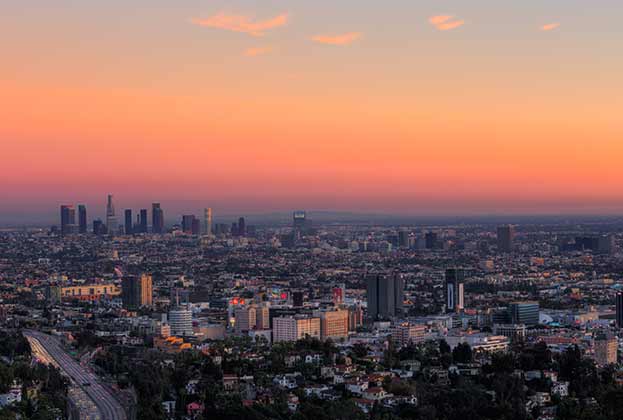During 2019, rental values outperformed capital values in our prime index. We look at both capital and rental value growth for each city and the factors that shape them
During 2019, the average capital value of prime residential properties across world cities remained flat, averaging an increase of 0.1%. This was down from 2.6% for 2018 and continued the slowdown in growth seen since 2016. The slowdown accelerated throughout the year and prices fell in many cities in the second half of the year resulting in an average decrease of -0.4% over the six months to December 2019.
Rental values performed better than capital values during 2019 with an average annual increase of 1.2%, an increase from the 0.4% average growth over 2018. But, like capital values, rental growth also slowed in the second half of the year, with a 0.3% increase compared with 0.8% for the first half.
Capital value growth by city
While prime prices on average remained flat through 2019, price growth varied across the index. Berlin and Paris were the strongest performers through 2019, with annual growth of 8.8% and 6.4% respectively. The German capital has seen strong interest from buyers and investors looking for income returns while prime property in the French capital is viewed as a safe long-term store of wealth. In both cities, undersupply remains a key driver of values.
Moscow was another strong performer during 2019 and one of only five cities in the index to see an increase of more than 2%, with annual growth of 2.3% to December 2019. The market in the Russian capital is being driven by a recovering domestic economy and falling mortgage rates. While the market remains predominantly domestic, there has been recent interest from Asian buyers.
In China, rising mortgage rates and financial de-risking generally dampened the national housing market. However, Hangzhou and Shanghai continued to perform well throughout the year, with growth of 4.8% and 3.3% respectively. These cities have strong business environments and continue to attract talent from other parts of the country.
Across the rest of Asia-Pacific, Singapore remained largely flat over the year, as cooling measures introduced in 2018 continued to have an impact. Nevertheless, the market saw a slight rebound in the second half of the year (+0.9%) as rising affluence among local residents and international buyer interest mean demand remains strong. Kuala Lumpur and Bangkok both experienced a 1.0% fall as the cities grapple with oversupply following a rise in residential development over the past few years.
Meanwhile, Hong Kong also experienced a fall in prices through 2019 following social unrest in the city and the US-China trade war. It was down 1.5% for the year and -2.7% during the past six months to December 2019.
In the US, Miami, San Francisco, New York and Los Angeles all experienced price falls throughout the year. Tax changes at the beginning of the year have reduced demand for prime properties while purchasers have become wary of buying near the top of the business cycle. Additionally, Miami and New York both have a high volume of prime stock.
London’s prime residential market has been impacted by Brexit uncertainty and stamp duty reform with prices down 1.5% for the year. Geneva’s market has also felt the effect of uncertainty from the UK due to the high share of international buyers in the market including British buyers.
Cape Town was the biggest faller in the index over the past year, with a 6.3% decline. After several years of outperformance relative to the national housing market, Cape Town’s prime market is undergoing a period of price corrections following weakened economic sentiment and slowdown in demand. Dubai saw the next largest yearly decline, with a 5.8% fall, as existing oversupply with continued high levels of completions impacted values.
Rental value growth by city
US cities generally saw capital values fall through 2019, but the rental markets have performed well as demand remains healthy. Los Angeles and Miami saw the largest increases in rents over 2019, with a 6.1% and 4.8% increase respectively.
Moscow saw the third highest growth in rental values over the year, with a 3.8% increase. The prime rental sector has seen high levels of activity with demand primarily driven from corporate tenants. Unlike the purchaser market, the rental market in Moscow has a high share of international demand.
Tokyo has seen strong growth in rental values over the past few years and increased 1.9% in 2019. However, rents fell marginally (-0.1%) in the second half of the year as some stock starts to look overpriced and landlords have become less bullish.
Rental values in Berlin experienced a 0.6% fall in the second half of the year despite a 2.8% rise for the year as a whole. Uncertainty around rental caps has dampened sentiment in the city viewed as an attractive residential investment.
Similarly, prime rents have remained flat in Paris following the introduction of rent controls in July 2019, although prime apartments are generally not affected by the measure and growth has kept in line with the market as a whole.
Dubai and Kuala Lumpur saw the largest rental falls over the year, with -5.0% and -4.1% respectively. Both markets are facing oversupply and potential renters have a lot of choice and negotiating power.
London saw a marginal fall for the year (-0.6%) but experienced a slight rebound in the second half of the year driven by strong activity and low levels of stock. Hong Kong was the only other city in the index to see an average rental fall through 2019, down 0.4%, which, like capital values, accelerated in the second half of the year with a 1.7% fall for the six months to December 2019.
Read the articles within Savills Prime Index: World Cities below.
.jpg)




